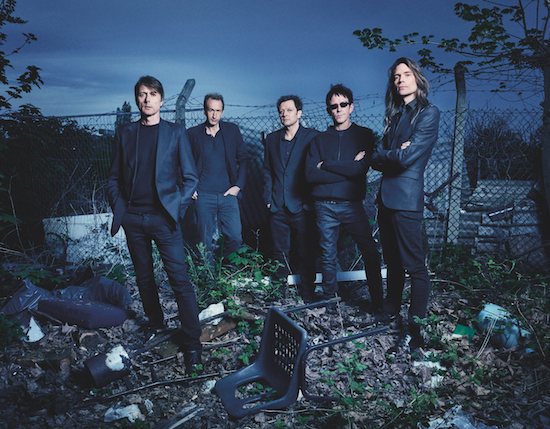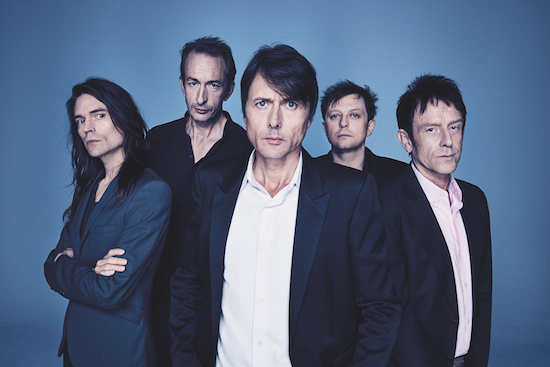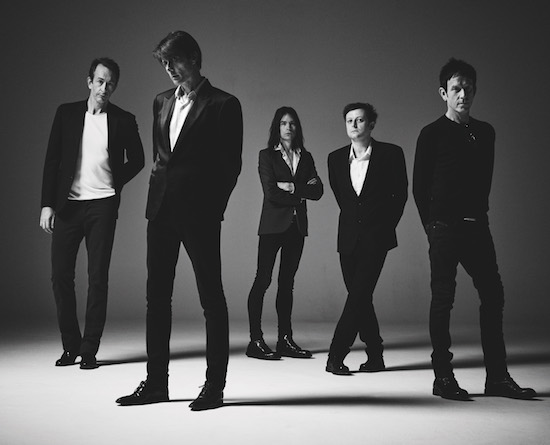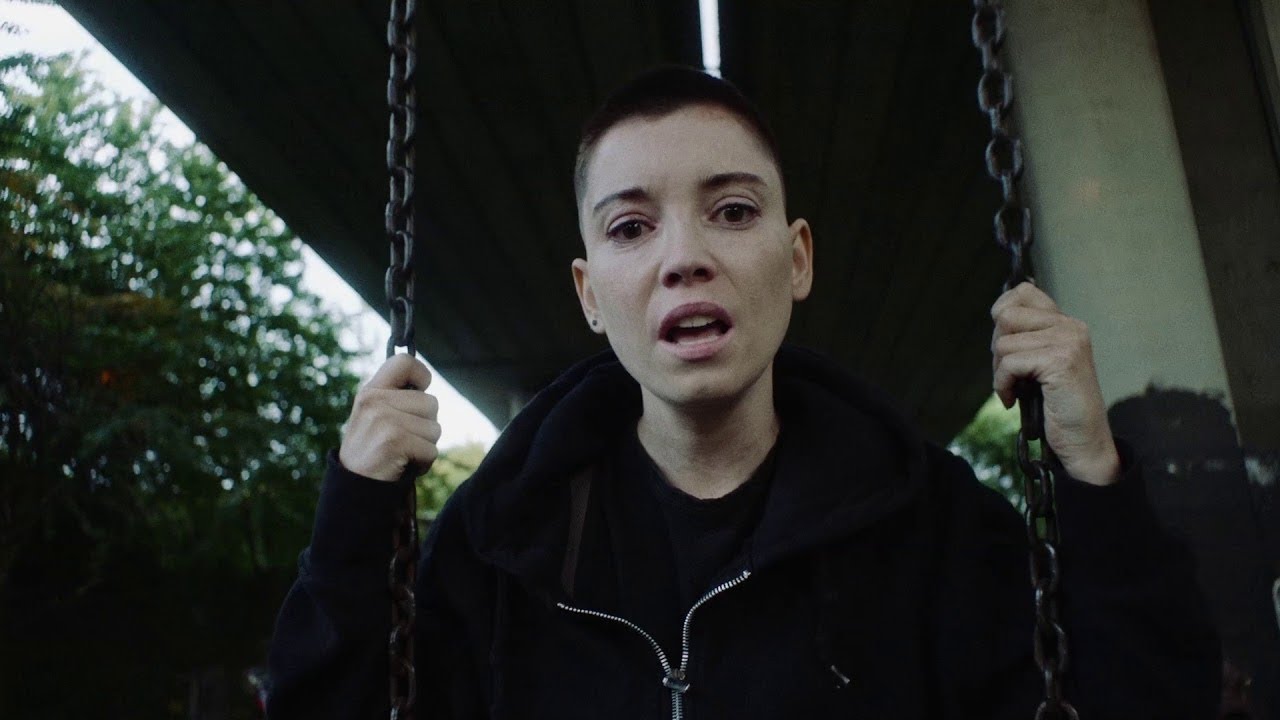I have to walk some distance from Notting Hill Gate to get to Brett Anderson’s house. Past a record shop I haven’t visited for years, beyond the penumbra of Carnival, to a tidy arc of elegant townhouses lining a peaceful street I’ve never had reason to walk down before.
Inside, nothing is on view. Everything is immaculate. He clearly lives to a minimalist ideal, with life’s necessary bits and bobs tucked out of sight behind featureless doors that could well be mistaken for wall panels. Even dressed in his scruffs (faded jeans! moccasins!) Anderson is impossibly – irritatingly – handsome. His chiselling maintains its youthful spatial integrity; his skin does not bear witness to his many historical years of debauch. He is welcoming and a good host (“Do I have green tea? Of course. Let me get you some”); and this is despite the fact that simply by being in his gaff, plugging in an iPhone, throwing my jacket over a chair, setting up a recorder, getting crumpled sheets of notes out of an old tote, I am clearly cluttering the place up. He unfolds immaculately onto an unreasonably large sofa facing me on the other side of the room. There’s a big space between us but nothing fills that gap. There are no photographs in frames, no niknaks, no piles of shoes, no half read newspapers, no childrens toys, no takeaway fliers, no TV remote… no TV in fact. At first it feels like Brett Anderson himself is the centrepiece in the dream home.
But in reality if this excessive tidiness is evidence of anything it is of a larger shift in focus. The core of the Suede singer’s life has been relocated to the Somerset countryside, where he now lives with his wife, a stepson and Lucian, his six year old. And this of course has knocked on to everything else, creatively speaking at least. The unthinkable has happened and the clearly defined milieu of Suede – the modern city edgelands of housing estates, late night cab ranks, bedsits, sodium-lit mean streets – has transmuted. The urban has become the rural.
One of his first creative acts on moving out to the sticks in the Summer of 2016 was to write a book and co-write an album in parallel. His (genuinely excellent) memoir, Coal Black Mornings came out in March of this year and deals with his life pre-fame so his move to the countryside is reflected most clearly in Suede’s new studio album – their eighth in twenty five years – The Blue Hour.
Speaking about the intense period of creativity Anderson says: “They definitely bled into one another. I’d be writing the album during the day time when the kids were at school, so I could make a lot of noise, and then once I’d done the school run and got them back home, I’d sit at my computer and write Coal Black Mornings quietly.
“And the memories that writing the book dredged up fed back into the writing of the songs for the album. A track like ‘The Invisibles’ was a very specific example of that. The protagonist is like a callow 17 year old who is tortured by unrequited love. So I was projecting myself now back into that version of myself and it ended up becoming a dialogue between me and my father.”
The idea of fatherhood looms large over both projects. Coal Black Mornings may well be dedicated to his son Lucian but Anderson went a step further with The Blue Hour, which features the six year old in a speaking role. He says: “Early on I knew I wanted the album to be from a child’s point of view. For the last two albums my muse has been my son. It used to be friends or lovers but now it’s him. I see life through his eyes. Every picture I take is a picture with him in it somewhere.
“With the album I wanted to write about childhood but not in a sugary way. And so I imagined the fearful world that a child sees, and in a way that became a reflection of my own childhood.”
As well as his son, his (eccentric and occasionally overbearing) father is also present on the album. (“There are little references to him here and there.”) It is clear he has spent a lot of time recently considering his place between these two figures: “The father is a reflection of the son and so on and so on. He is a point on a continuum.”
The phrase ‘speaking as a father’ is often the last refuge of the scoundrel so, speaking as a member of the human race, I feel duty bound to point out to him that there is a darkness on the album that I wouldn’t wish upon my worst enemy. The subject matter is not something I could spend any amount of time meditating upon myself. There are no spoilers in music but I’m aware that talking excessively about the narrative of this album could detract from a perceived puzzlebox element to this record. Let us leave it at this: the blue hour of the title refers not just to twilight but it marks the point where concern for a missing child turns into anguished hysteria as night falls.
Anderson considers the question carefully: “I almost don’t want to let these things into the room but then I can’t help it. The way I deal with it, morally, is that there’s no suggestion in which I’m wishing any of this upon my son. The scenario is a fear that all parents have, and the album also involves me seeing myself as a child and displaced and lost in the woods. So the theme is more metaphorical than anything else.”
Lucian’s star turn behind the mic is undoubtedly one of the album’s odder moments. The proud dad explains: “‘Dead Bird’ is a recording of me and my son talking; it was just a lucky accident. I had tried to get him to read things out but because he’s only five, it just sounded really wooden. It didn’t work at all. So I just thought, ‘Ok, I’m going to go into the garden and try and to create a scene which will pique his interest.’ So I went into the garden and started digging and, intrigued, he came over and said, ‘Daddy, what are we digging for?’ So I said, ‘You know what we’re digging for.’ And luckily he said, ‘The dead bird.’ And it was just brilliant. A few months before I’d buried a dead bird for him, you see, because we were going to dig it up and look at its skeleton. I do this sort of thing with him quite a bit. How was it? It was horrible really – I think we’d dug it up too early. It needed a while longer.”
Referring to the other field recordings – of a group of adults frantically searching for the missing child played by his son – he says: “I’ve lived properly in the Somerset countryside for two years now, where it’s legal to do things like that and no one can hear you scream.”
He continues, gingerly: “If there’s one thing that no one tells you before you have a child, it’s how terrified it will make you. The utter fear that if something happens, how impossible it would be to recover and the fact that your life would effectively be over. In a way it’s stronger than the fear about your own mortality, it’s a different level of fear.
“I’ve always had this… my mother died of cancer. I’ve always had this obsession with cancer and avoiding it if I possibly can but that’s nothing compared to my fears for the wellbeing of my family. I suddenly feel much more vulnerable now I have a family. When it’s four in the morning and you’re thinking, ‘God, what if something happened?’ I absolutely reject the idea that if you have a so-called straight or comfortable life this stuff is somehow easier – it isn’t. When you have a family you have so much more to lose.”
He brightens and adds: “So initially all I had was this theme of childhood. And once I had that initial idea then I had to come up with more ideas, through brainstorming. I isolated myself in the countryside with Richard and Neil and started writing songs. It felt almost like we were in a creative crucible…”
And if you speak of handsome devils, then they will arrive. Lead guitarist Richard Oakes and keyboard player and rhythm guitarist Neil Codling, join the lyricist on his remarkably large sofa. Together they make up the songwriting core of the band. The two guitarists are dressed like the eternal students that I guess in some ways they are but each having his own sartorial spin on this look that probably mirrors his role in the wider songwriting dynamic. Codling, who has recently become the band’s de facto arranger and producer, is more of a fine-detail aesthetician to Oakes’ (self-proclaimed) engineer; someone unafraid to roll his sleeves up and take a peek under the bonnet.

If Anderson is a country gent now, this hasn’t been a move adopted by the whole band. Codling is keen to re-establish the urban credentials of the rest of them: “Yes, the rest of Suede are still city boys, apart from Simon who lives in rural Thailand next to a rice paddy. That’s about as countryside as you can get.”
The singer chimes in: “Moving to the countryside has made me miss London. When I come back to London I just breathe it in. The countryside is amazing when the weather is good and at this time of year it’s beautiful. I go out and sit in the garden with my boy and I say, ‘We are blessed.’ But then in November it’s like a fucking nightmare.”
Codling jokes good naturedly: “You know how Brian Wilson had to put the feet of his piano in sand while he was writing? Well Brett now has his piano standing in a gravel pit to remind him of the city.”
Anderson recalls the trio’s initial songwriting sessions in his rural kitchen with a perverse fondness: “We wanted to do that thing of us three disappearing off to the countryside. And in the process I thought we would go a bit mad, and end up almost murdering each other.”
Luckily it didn’t come to that and one of the first things to emerge from the session was the maximal, jaw-dropping and gothic ‘As One’. Oakes says, “As soon as we came up with it we said, ‘OK… it’s going to be that kind of record.’ So despite the blazing sunshine outside, we knew it was going to be a cold record.”
Anderson explains: “There are always what I call anchor songs on each album. And it’s often that song that sets the blueprint for the album. When you start making a new album you’re fumbling about with vague ideas but until you write that song, you don’t quite know where to go with it.”
‘As One’ is certainly the most dramatic album opener the band have written since ‘Introducing The Band’ and probably their most dramatic album opener full stop. Anderson says it had a Cecil B. DeMille size from the start and Codling agrees that even as a demo it had a menace to it: “However big you want to make it, you can do. It can still take a choir, it can still take a string section.”
Oakes drops a tantalising hint that ‘As One’ is perhaps Suede’s ‘Helter Skelter’, an epic, and heavy track possessed of so much gravity that needed heavy editing to make it album compatible. He suggests that really they could have gone much further with it: “For a while Neil and I were fiddling about with this 15-minute-long version which just smashes into a wall and goes straight into ‘Wastelands’. But nobody will ever hear that…”
Even as it is, ‘As One’ set the tone for what would become a bold record indeed. Taking something of a gamble in today’s unforgiving marketplace, the band opted for producing a cohesive whole designed to be listened to in one sitting, as opposed to a collection of stand alone Suede bangers ready to be strip-mined and isolated for Spotify playlist inclusion. If this approach has seen them shunned by the kind of radio stations who would normally support them, then more shame on the querulous, narrow shouldered types who construct radio playlists and have little faith in the intelligence or taste of their listeners. (And double shame on them for not fully realising the radio potential of ‘Cold Hands’, ‘Life Is Golden’ and ‘Flytipping’ – experimental album or not.)
As it is The Blue Hour stands alone in their back catalogue as a fully realised concept album which achieves cohesion via narrative, lyrics, spoken word passages, repeated musical themes, field recordings and narration. If I had to compare it to anything from their back catalogue I’d mention Dog Man Star – not something I do lightly – and that would be in terms of ambition, execution and impact. It slaps hard. Once you have acclimatised to it, The Blue Hour makes you grin and shake your head at their sheer chutzpah. It makes your heart rage behind your ribs. It reactivates long-snoozing sensuous psychedelic glam glands. It demands an immediate rewind.
Like with any classic album in a band’s catalogue, it can feel like everything has been leading up to this point. After their return in 2010 they had a lot to prove. First that they had to show that they had the damned verve necessary simply to be Suede as a live entity once more. This was quickly asserted with savage efficiency by a blistering fanclub gig at the 100 Club and then an all time best show at the Royal Albert Hall. The Bloodsports album in 2013 was, in part, an act of contrition for relaxing their standards somewhat with 1999’s Head Music and abandoning what it meant to be Suede entirely with 2002’s A New Morning. They were reconnecting with the core idea of the group in 2013 – it was a reboot, if you will. With Night Thoughts, in 2016, the cinematic sequencing of the tracks created its own forward momentum and bound the tracks together somewhat but it was The Blue Hour that sealed the deal.
Referring to the album as a unified piece of work Codling says: “We live in the world of Spotify and Deezer when you’re supposed to write songs and hope that they end up on playlists, because that’s how you play the music business these days. We thought we’d be bloody-minded and make something that people would have to listen to for three quarters of an hour. People do listen to long playlists and they do watch box sets, so they do have longer attention spans than they’re given credit for. We decided to introduce listeners to a sound world that they can move through. The narrative is there but you don’t necessarily need to know what it is; it’s more like the scaffolding.”
Anderson nods: “Yes it is. The narrative is the scaffolding that allows us to arrange the tracks and once they’re in place we can take the scaffolding away.”
“Otherwise”, notes Codling, “it becomes like Jonathan Livingston Seagull or some turgid, 70s concept album.”
The band have referred to the album as the closing chapter of a triptych. If the original intention was to have a unifying sonic identity binding the three albums together in a series however, this was upset when original producer Ed Buller left the project before it was complete – something that has actually proved serendipitous in the long run.
Buller – who had previously worked on Suede, Dog Man Star and Coming Up as producer and engineer as well as producing all of Bloodsports and some of Night Thoughts – was so trusted that he had essentially become a sixth member of the band, song veto and all. But he was courted by Hollywood and relocated to California, thus creating a very Suede-like problem. The tone in Oakes’ voice when he says, “Well, we weren’t going to record the album in Los Angeles…” suggests that actually a winter recording session in the frozen ice fields of the permanently night-bound Patagonia was a more likely scenario. Anderson nods calling the very idea of them recording in America at all “bizarre”.
The band, impressed with his work on various albums by Ride, Foals and The Killers, got in touch with lauded mixer Alan Moulder, who agreed to come out of retirement as producer to work on their record at Assault and Battery studios, London. “I think once we reassured him that we weren’t dysfunctional and were actually hard working he was quite happy with the idea. I think he’s worked with a lot of dysfunctional bands in the past. He did the second Elastica album didn’t he? You can imagine what that must have been like”, says Oakes, before adding: “Bless them…”

But really, all due respect to the great alt-rock mixer, the most significant thing about the departure of Buller wasn’t that it created room for Moulder but that it created even more room within the band for Codling. Self-effacing isn’t quite the term for it when the keyboardist says: “We had to pick up what [Buller] left us of Night Thoughts and cobble it together into what came out.” All the evidence shows that the six months he spent completing that album gave him the confidence to assume the role of de facto producer, or co-producer, on the current one.
Anderson agrees: “The fact that Neil did most of the last six months on Night Thoughts on his own gave us the confidence to look at The Blue Hour slightly differently. Ed previously had been a real tastemaker, saying, ‘This is good’ or ‘No, that’s not good enough’ which created a bit of a weird dynamic. You stop being able to really trust yourself. And with The Blue Hour we got confidence back in our own judgement.”
When Codling says, “There are songs that would never have made it onto the album if Ed had been involved, songs like ‘Roadkill’, ‘Chalk Circles’ or ‘Tides’ for example”, he hits on something quite important. Ed Buller’s departure freed up Suede to make their grandest and yet most experimental album to date.
In terms of grand ambition, the most noticeable thing on the album is the use of strings and a choir. The Prague Philharmonic appear on nine tracks – all but one of which were arranged by Codling. (‘The Invisibles’ was the work of Craig Armstrong who had worked with the band on Coming Up.) But this isn’t the case of an orchestra being used to hide a multitude of sins or to imply emotion or drama where there is none. As Oakes points out: “Strings framed things on the last album whereas on this album they are part of the picture.”
It is fascinating hearing a string section suddenly become a vibrant and essential part of the Suede sound, rather than simply an occasional colouring device. But any fans worrying that this heralds a slump into tepid, middle age should reassure themselves that if anything, the opposite is true. Just as Neil is happy to list classical pieces which informed his approach to writing orchestrally for the group (“Ravel’s ‘The Child And The Spells’ and ‘Mother Goose’… Debussy’s ‘The Snow Is Rising’… The strange sense of foreboding created by ‘The Threnody To The Victims Of Hiroshima’ by Penderecki…”) he is also happy to list the more leftfield influences that informed the album’s wild and psychedelic moments such as ‘Chalk Circles’ and ‘Dead Bird’ (“Velvet Underground’s ‘The Gift’… Electric Ladyland by Hendrix…”)
‘Roadkill’ is one particular dramatic, narcotic, poetic passage that ramps up the manic air of rural terror, standing somewhere between Edgar Allan Poe’s ‘The Raven’, Ted Hughes’ ‘February 17th’ and David Bowie’s ‘Future Legend’, being conjured amid the ebb and flow of scraped strings, controlled feedback, heavily phased vocals and dubbed out tendrils of noise disappearing recursively into the mix. The singer says: “I think it’s a risk. And if people want something to beat us with we’re handing them a stick with these songs but sometimes you just have to take that risk.
“It’s quite a brave track to come up with – you have to be quite confident. It teeters on the line doesn’t it? Some people would say it was quite pretentious with me reading this Edgar Allen Poe-like verse about a dead bird. I mean, it doesn’t sound like the Stereophonics.”
And the influences don’t just stem from the musical leftfield either. Codling adds: “A lot of folk horror is set in that kind of Claude Lorrain, chocolate box, pastoral vision of the rural before it ends up revealing itself to be something much darker. When we were writing the album we wanted to reference films like The Wicker Man (1973), And Soon The Darkness (1970) and Penda’s Fen (1974). At the same time I was reading a lot of [British folklore inspired fantasy novelist] Alan Garner and it kind of bled into the whole feeling.”
The carrion and the folk horror all conspired to create a very specific geographical place. Anderson says: “The Blue Hour in a very unpleasant version of the English countryside and not what you would find in a or John Constable painting. I wanted to portray the countryside as quite a bleak, unpleasant landscape. The roadkill, the b-roads, the fly-tipping. As a city dweller you can kind of romanticise the countryside as this kind of Arcadian idyll. And having lived there again for a couple of years, it just isn’t. There is a lot of ugliness and cruelty. Take the cows lowing. Someone told me the reason female cows low a lot – you hear them groaning – is because they’re separated from their calves. That puts a really different perspective on things. We live near a farm and I used to think, ‘Oh, that’s a nice sound isn’t it?’ And now when I hear it I just think of these mothers who have had their babies torn away from them. I like to think about the darkness in all things and I don’t really think Suede works unless we look at the darkness. It’s what I like to tease out in our music.”
The Blue Hour is out now




